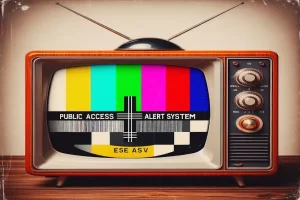The Mandela Catalogue has quickly become one of the standout names in modern analogue horror, captivating audiences with its unsettling approach to terror. Blending the eerie, low-fi aesthetics of VHS tapes and distorted broadcasts with deeply psychological horror, this series has made a lasting impact on the genre. Its use of retro technology and corrupted media draws viewers into a nightmarish world where the familiar becomes horrifyingly unfamiliar, tapping into deep-seated fears of the unknown and the uncanny.
What makes The Mandela Catalogue stand out is not only its masterful use of analogue aesthetics but also the complex, chilling themes it explores. The series combines existential dread, psychological unease, and surreal terror, creating a truly unique horror experience. In this deep dive, we’ll explore the series’ themes, its influences, and why it has been hailed as a modern classic in the world of analogue horror. Whether you’re a fan of the genre or a newcomer, The Mandela Catalogue is a must-watch for anyone looking to understand the terrifying potential of analogue horror.
What Is The Mandela Catalogue?
Overview of the Series
The Mandela Catalogue is an internet-based analogue horror series created by Alex Kister that has quickly gained a cult following for its eerie, unsettling atmosphere and disturbing themes. The series is set in a world plagued by “Alternates”—disturbing, almost-human entities that can take on the appearance of real people, but with grotesque distortions. These beings invade the lives of ordinary people, warping reality and creating an atmosphere of constant unease. The horror comes from not only the terrifying visuals and sounds but also from the psychological dread of not knowing who or what is real.
The series unfolds through a variety of media formats—grainy VHS tapes, distorted audio recordings, and eerie public service announcements—reminiscent of older horror films and the analog era. The “found footage” style used in The Mandela Catalogue makes it feel like the viewer is uncovering forbidden, lost media, which only intensifies the fear. As the series progresses, it reveals a fragmented, apocalyptic world where the lines between reality and distortion blur, creating a tension-filled, surreal experience for its audience.
The Creator and Influence
The Mandela Catalogue was created by Alex Kister, an independent filmmaker who has emerged as a key figure in the modern analogue horror scene. Kister’s work is heavily influenced by a blend of classic horror and newer internet-based horror trends. Drawing inspiration from older films like The Blair Witch Project and Marble Hornets, which pioneered the found footage genre, Kister incorporates similar techniques—such as warped visuals and disorienting audio—into the series to enhance the horror.
However, The Mandela Catalogue also brings something new to the table, particularly through its exploration of psychological horror and existential themes. It doesn’t just rely on jump scares or grotesque imagery; instead, it leans into the fear of the unknown, forcing the viewer to confront disturbing concepts about identity, reality, and the nature of human existence. This mix of old-school analogue horror with psychological terror has made The Mandela Catalogue a defining series in the genre and a standout example of how internet-based media can continue to push the boundaries of horror.
The Analogue Aesthetics of The Mandela Catalogue
VHS-Like Visuals and Audio
One of the standout features of The Mandela Catalogue is its masterful use of VHS-style grainy visuals and glitchy audio, which immediately transport viewers to a time when VHS tapes were the primary means of watching movies and shows. The series takes full advantage of this aesthetic, incorporating heavy distortion, color shifts, and static into its visuals, creating an atmosphere of unsettling nostalgia. This visual style not only adds to the sense of dread but also plays on the idea of “found footage,” making the viewer feel as though they are discovering an old, forgotten tape that has been lost to time.
The accompanying audio is just as crucial in establishing the series’ eerie tone. The distorted sounds, muffled voices, and occasional feedback add to the sense that something is horribly wrong, pulling the viewer deeper into a world where reality is constantly shifting. Much like the visuals, the audio quality is purposefully degraded, giving the series a raw, unpolished feel that contributes to the notion that this media is not only old but also dangerous, creating an unspoken tension that lingers throughout each episode.
The Imperfection of Analogues as a Horror Tool
In The Mandela Catalogue, the imperfection and unpredictability of analogue technology are not just stylistic choices but vital components that heighten the horror. The physical limitations of older technologies—such as audio degradation, video glitches, and visual distortions—create a sense of discomfort and unease that digital media simply cannot replicate. These imperfections don’t just make the footage look “old” or “outdated”; they add a layer of horror by suggesting that something is breaking down, malfunctioning, or corrupting in real time.
For viewers, the unpredictable nature of analogue technology amplifies the tension. Static and distortion become harbingers of something unseen or unknown, and every flicker or sound anomaly raises questions about what is real and what is part of the distorted nightmare the series presents. The sense of chaos that arises from these imperfections mirrors the psychological horror at the heart of The Mandela Catalogue—where nothing is certain, and the boundaries of reality and fiction constantly blur. This sense of a broken, surreal world, fueled by analogue’s inherent flaws, makes the series’ horror feel far more visceral and unnerving.
Themes and Storytelling in The Mandela Catalogue
The Concept of “Alternates”
At the core of The Mandela Catalogue lies the chilling concept of “Alternates”—sinister doppelgangers that not only replace people but also distort reality itself. These entities are unsettling not just because they look like familiar people but because they subtly alter the world around them, warping reality in ways that seem almost imperceptible, yet profoundly disturbing. The Alternates are more than just monsters; they are manifestations of our deepest fears about identity, loss, and the fragility of the self. They blur the lines between who we are and who we appear to be, tapping into the terrifying possibility that the people we trust may not be who they seem.
The fear of being replaced by something “not quite right” resonates on a deeply primal level. The Alternates make viewers question the authenticity of everything—how can we trust our senses if our world is constantly shifting under the influence of these dark reflections? The concept forces us to confront the idea that we may be lost or subsumed into something else, losing our individuality in the process. This fear of identity being erased and replaced by something unknowable is at the heart of the series’ horror, adding layers of psychological unease to the already uncanny atmosphere.
Psychological and Existential Horror
The Mandela Catalogue masterfully weaves psychological and existential horror, pushing its characters—and viewers—into states of paranoia and confusion. As the story unfolds, characters are constantly subjected to the feeling of being watched or manipulated by forces beyond their understanding. The series taps into the deep-rooted fear that we are never truly alone, that something or someone is always observing us, waiting to intrude upon our lives in disturbing ways. This constant sense of surveillance is pervasive, contributing to a growing tension that builds throughout the series.
On a deeper level, The Mandela Catalogue explores existential horror, questioning the nature of reality itself. The characters struggle to understand what is real and what is distorted, as their perception of the world begins to fragment. They are left in a state of helplessness, unable to escape the terror that pervades their existence. This struggle to comprehend one’s place in a world where the rules are constantly shifting mirrors the existential dread of being trapped in an unknowable universe, where meaning and control slip further away. By combining psychological terror with existential themes, the series not only unsettles but also invites viewers to confront their own fears about identity, reality, and the meaning of existence.
The Impact of Sound Design in The Mandela Catalogue
Eerie Soundscapes and Distorted Audio
In The Mandela Catalogue, sound design is an essential tool in creating an atmosphere of dread. The series expertly uses a variety of unsettling audio cues, including hissing, static, and distortion, to enhance the eerie, otherworldly feel of the narrative. These sounds, often reminiscent of malfunctioning electronics or degraded recordings, contribute to a sense of unease by mimicking the imperfections of analogue technology. The hiss of static or the buzz of distorted frequencies instantly signal that something is wrong, drawing the viewer into a world where every sound feels unnatural and threatening.
Distorted voices and fragmented audio further intensify this discomfort, as familiar sounds become unintelligible or warped beyond recognition. These audio distortions mirror the corrupted reality the characters face, where truth becomes as difficult to discern as the sounds themselves. The eerie soundtrack, combined with the crackle of radio interference, amplifies the tension, making even the smallest noise feel like a harbinger of something sinister. Through the use of unsettling soundscapes, The Mandela Catalogue makes its viewers feel as though they are trapped in a malfunctioning world where everything—sounds, sights, and reality itself—can turn against them at any moment.
Silence as a Tool of Terror
In addition to the disturbing audio effects, The Mandela Catalogue also employs silence as a powerful weapon in its horror arsenal. Silence, or the absence of sound, is used strategically to create moments of heightened tension, where the lack of auditory cues leaves the viewer on edge. During key scenes, the absence of sound heightens the audience’s sense of isolation and vulnerability, as they are left to imagine what might be lurking just out of earshot. These moments of eerie quiet make the viewer more aware of the potential for danger that could emerge at any moment, but without warning.
The absence of sound during critical moments makes the few sounds that do occur—whether a distorted voice or a sudden, distant noise—feel all the more jarring and unsettling. Silence, when used effectively, becomes a force in itself, amplifying the terror of what is unseen and unheard. It allows the viewer’s imagination to run wild, and in horror, there’s nothing more terrifying than the fear of the unknown. By mastering both sound and silence, The Mandela Catalogue keeps its audience in a constant state of discomfort, where every moment is charged with a sense of impending doom.
Conclusion
The Mandela Catalogue has undeniably earned its place as a modern classic in the analogue horror genre. Its brilliant fusion of psychological terror, unsettling vintage technology, and existential horror elements creates an experience that resonates deeply with audiences. The series taps into primal fears of identity, the unknown, and the collapse of reality, all while using the imperfections of analogue media—grainy visuals, distorted audio, and eerie silence—to amplify its sense of dread.
Through its chilling storytelling, The Mandela Catalogue stands as a shining example of how the analogue horror genre can blend nostalgia with genuine terror. It proves that there’s something inherently unsettling about the combination of old technology and the uncanny, where every crackle, glitch, and distortion adds another layer to the horror. With its haunting “Alternates” and surreal, psychological narrative, the series invites viewers into a world where nothing is quite as it seems, leaving them with a lingering sense of fear that’s hard to shake off.
If you haven’t yet experienced The Mandela Catalogue, now is the time to dive in. Check out Local 58 in case you’re looking for more options!




